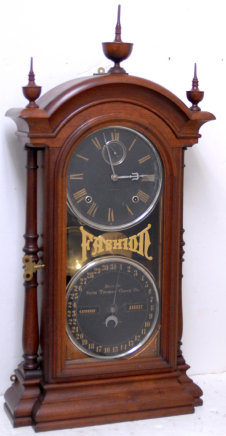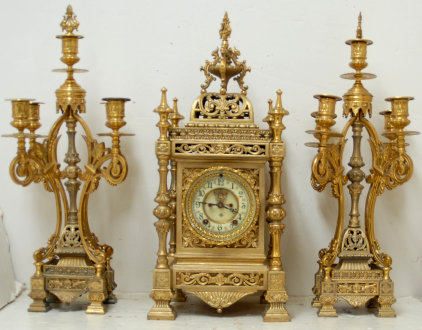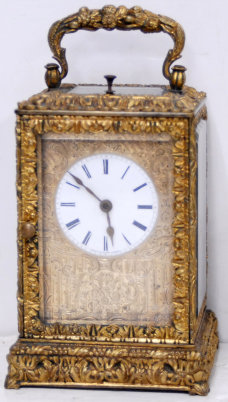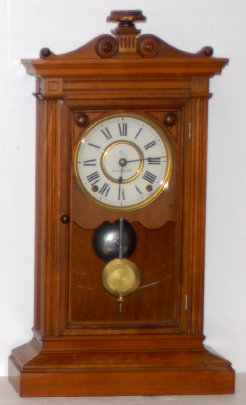

154. $875
“Munger & Benedict / Auburn, N.Y.”, Ironing Board top shelf clock, ca 1833. Munger made high grade 8-day brass movement clocks using prison labor at the Auburn State Prison. Clocks were numbered probably for accounting reasons for they had a 3-year contract with the New York Prison System. Numbers from 203 up to 2877 have been reported. This triple decker case is 39” tall, has differing shades and grains of veneer, ironing board top and carved half columns. It has been cleaned and polished, patched and repaired as needed and presently needs a couple of small veneer repairs. There are the usual nicks and bruises on the corners and edges but hardly noticeable. There is a mirror in the bottom door that is no doubt a replacement. We have seen doors with two glasses and some with one glass. Upper glass has reverse painted designs and it is a replacement glass. The entire backboard is covered with wallpaper. Two sets of wood pulleys, compounded at the top to hold the large and heavy iron weights. There is a nice complete paper label inside. The painted dial is in good condition and holding the paint. Brass movement runs 8-days and strikes a bell mounted above the movement. The hands and the flying eagle pendulum are original. Munger was only active in the business from May thru November 1833 when this clock was made. He turned over the business to Hotchkiss & Benedict who made clocks in Munger’s name until 1837. This style clock used to sell between $3000 and $4000 at auction. $1000-$1250.

155. $800
Munger & Benedict, Auburn, NY, 8-day, time and strike, ironing board top, carved column shelf clock, ca 1833. The mahogany veneered case is 38 inches tall, the case is clean and polished, no veneer repairs stand out, only some scuff marks from hauling but polish will cover those. The mirror looks to be old but the painted top glass is probably a replacement. The dial is too nice to have not been repainted and the hands and weights are probably replacements. The ironing board top has some painted trim around the front edge and the carved half columns are very nice. This clock is not as nice as #154, hence the lower minimum but it is as nice looking but the replaced parts brings it down a notch. The wall paper backing that covers the case inside is still very nice, the eagle pendulum, complete label, and the 8-day movement are all correct. It is running and striking on a bell. $1000-$1250.
153. $1250
Ansonia Clock Co. metal case clock, “Regent with Candelabras”, ca 1904. I have had this clock
for a while, never displayed where folks would admire it, but tucked away in the dark because I did not want to sell it. It was refinished
years ago in the original gold color, by the late Bruce Baziluk. Every smidgen of the case and candelabras was redone, so if you don’t
like gold don’t buy this one. The clock is 22 ˝” high and the candelabras are 20 inches high. It has cast metal pieces of all descriptions
assembled into a very attractive clock. If it has a fault it would be that it is heavy. I have not seen but a couple of this
model before so I cannot judge the value or collectability, however, if I have not seen many they must be rare. The ones I have seen
did not have the candelabras. The glass is beveled, hands are correct and there is an open escapement mechanism. The movement is 8-day,
and is signed. The movement is running and striking a rack and snail strike on a standing Cathedral gong, clock strikes hours and
half hours, and there is a correct pendulum and key. This is a keeper. Ly-Ansonia #1548. $1250-$1750.

152. $1250
Southern Calendar Clock Co. St. Louis, Mo., “Fashion No. 4”, ca 1880. Walnut case is 32” high,
dark but retains the original finish. It has been restored, in that the dials have been repainted black, paper calendar rolls replaced
to black, and the finials are glued in so I cannot evaluate them. The walnut finials are exactly like the originals. The running and
calendar movements are operating properly, and inside is the original black and gold label of instructions and the white label telling
you not to oil the calendar movement. The brass pendulum and wood stick look like what you would see on a No.4 but it is a little
too large. It looks fine, runs as it should, and no one but you will know the difference. You should have a brass pendulum that is
2 5/8 inches in diameter. Large brass bell is clean and bright, has correct hands, and it has nice nickeled dial rings. The etched
designs on the dial board retains all of the original gilt, the tablet is excellent, and as usual I was disappointed when I looked
in the secret compartment, there was nothing there. Overall a very good example of this model. The previous collector had the clock
restored to look like the No.6 black dial models. Like him, if you have always wanted a black dial Fashion but did not want to pay
$4000, this is an ideal substitute. I have had it in my office for some time and no one knows the difference. Ly-Calendar, page 286;
also in the Ly-Seth Thomas book. $1250-$1500.


157. $1500
“Bolviller a Paris”, signed on the porcelain dial and movement of this unusual and early brass carriage clock, ca 1848-1858. Bolviller had some connection with Japy Freres in the early clockmaking years. Brass case is 7 inches high with gilt castings and heavily engraved back door and dial plate. Both the front and back doors are hinged, with original pull knobs. Back door also has a movable plate inside the door accessible from the outside allowing access to winding arbors and hand set, without opening the door. The 8-day movement runs and strikes. Strikes one time on both half hours and hours. Most unusual and probably earliest of any of the rare carriage clocks we have sold. $2000-$2500.


158. $225
Seth Thomas Clock Co. City Series clock, “Greek”, ca 1879. Walnut case is 24 inches high, clean
and in good original condition, with no repairs or new wood. It has a side key lock, knob on the door, and original glass. The old
black label came loose in the base of the case and is now in an envelope. It can be glued back in place if you so desire. The nice
ST pendulum bob, nickeled bell, brass dial rings, and hands, are all original stock. The two-piece dial is signed and surprisingly
in very good original condition. The 8-day lyre movement runs and strikes hours on the nickel bell. Some collectors have asked me
how the “Greek” could be a City Series model. There are many Greek/Greece named cities in the northeast. Ly-Seth Thomas #545.
$400-$600.